When installing a room divider, there are several factors to consider to ensure that the divider is functional, safe, and suitable for your space.
- Purpose: Consider the purpose of the room divider. Are you looking to create a separate space, improve privacy, or reduce noise levels? This will help you determine the best type of divider for your space.
- Material: Choose a material that is suitable for your space. For example, if you need a divider that is easy to move, a lightweight material like fabric or paper might be a good choice. But if you’re looking for privacy, a solid material like wood or metal would be better.
- Size: Make sure to measure the space where you plan to install the room divider. This will help you determine the size of the divider that you need and ensure that it will fit in the space.
- Style: Consider the style of your room or space and choose a room divider that will complement it.
- Safety: Make sure to check local building codes and safety regulations to ensure that the divider you choose meets all necessary safety requirements.
- Installation: Consider the installation process of the room divider and ensure that it is appropriate for your space and that you have the necessary tools and skills to install it.
- Maintenance: Take into consideration the maintenance and cleaning of the room divider, choose a divider that is easy to clean and maintain.
- Lighting: Consider the lighting of the room and the impact of the divider on natural light, especially if you are using a solid material.
By considering these factors, you can make sure that the room divider you choose is functional, safe, and suitable for your space.
1. Bookshelf Room Divider

A bookshelf is not only a terrific method to divide a room, but it can also be used to store things like picture frames, books, and other items that are used for decoration.
- Increased storage: Bookshelf wall dividers can provide additional storage space for books, magazines, and other items. This can be especially beneficial in small spaces where storage is limited.
- Improved organization: A bookshelf wall divider can help to keep items organized and easily accessible. This can make it easier to find what you’re looking for and can also make a space feel more organized and clutter-free.
- Enhanced aesthetics: A bookshelf wall divider can add visual interest to a space and can be a stylish way to divide a room. They can be made out of different materials like wood or metal, and painted or stained to match the aesthetic of the room.
- Increased functionality: Bookshelf wall dividers can serve multiple purposes, they can also be used as room dividers, display spaces, and decorative elements in addition to being used for storage.
- Cost-effective: Bookshelf wall dividers can be an cost-effective way to divide a room, it can be cheaper than installing traditional walls and it allows for more flexibility in terms of design and layout.
- Versatility: They can be used to divide rooms of any size and in any type of space, from homes to offices, and libraries. They can be used to separate a living room from a dining room, create a home office, or even create a cozy reading nook.
- Cost: Bookshelves wall dividers can be more expensive than traditional room dividers, as they often require more materials and expertise to construct.
- Weight: They can be heavy and bulky which can be difficult to install, in some cases it may require structural modifications.
- Stability: bookshelf wall dividers can be prone to instability, especially when they are not anchored securely to the wall or floor. This can be especially dangerous in households with young children or pets.
- Dust: Bookshelves can collect dust and other debris which can be harmful to the books and items stored inside. Regular cleaning will be required to maintain the bookshelf in good condition
- Limited Use: The design of the bookshelf wall divider can limit the use of the space, in some cases the bookshelf can take up too much space, limiting the room usage.
2. Sliding Room Dividers

If you want to be able to open up or seal off a space according to the requirements of the situation, sliding dividers can be an excellent choice. These partitions can be constructed out of a wide variety of materials, such as wood or glass, and serve the purpose of erecting a wall that is either temporary or semi-permanent.
- Increased room arrangement and usage flexibility: Sliding wall dividers can be opened and closed effortlessly. Without permanent walls, this makes room reconfiguration easier.
- Sliding wall dividers maximise space. When not in use, they can be used to divide a room into a living area, home office, dining area, and play area.
- Sliding wall dividers can match a room’s decor and offer visual appeal. They can be made of wood, glass, or metal and finished in various colours.
- Sliding wall dividers with large windows or glass panels let more natural light into a room. This makes the space feel more open and saves energy by lowering artificial lighting.
- Cost-effective: Sliding wall dividers may be constructed fast and without major structural alterations, making them cheaper than permanent walls.
- Versatility: Sliding wall dividers can be utilised in homes, businesses, restaurants, retail stores, and more.
- Improved soundproofing: Some sliding wall dividers can be constructed with soundproofing material to reduce noise between places, which is especially useful in open-plan spaces, quiet offices, or sound-isolated spaces like recording studios or medical facilities.
- Space: Sliding wall dividers require a certain amount of space for the panels to slide back and forth, which can limit the usable space in a room.
- Complexity: They can be complex to install and maintain, and may require the services of a professional.
- Weight: they can be heavy, so they need to be on a sturdy and well-installed track to work properly and not to cause any accidents.
- Noise: Sliding wall dividers can make noise when in use, which may be disruptive in quiet environments.
- Maintenance: they require regular maintenance and cleaning to ensure smooth movement and durability.
3. Room Divider Screens
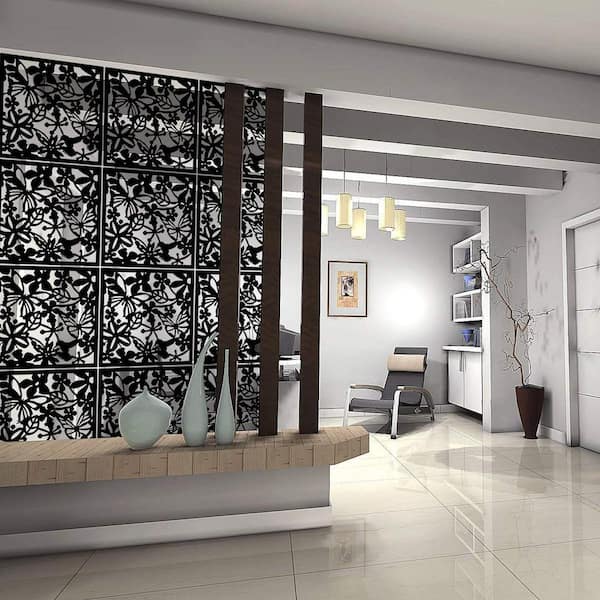
When it comes to splitting up a space, room divider screens are a common option. You may use them to add a beautiful touch to a room, and they can be fashioned from a variety of materials such as wood, rice paper, or fabric.
- Privacy: Room divider screens can divide a room or hide particular portions. This is especially useful in open-plan areas with little seclusion.
- Room divider screens can match the space’s decor and offer visual appeal. They can be made of wood, metal, or fabric with different finishes and colours.
- Increased functionality: Room divider screens can be used for privacy, decoration, or to create a place for reading or working.
- Cost-effective: Compared to creating permanent walls, room divider screens may be put fast and don’t require any structural alterations.
- Room divider screens are lightweight, portable, and foldable. They’re ideal for renters or individuals who often rearrange their furniture.
- Improved natural light: Translucent or see-through room divider screens let more natural light in and lessen the demand for artificial lighting.
- Increased soundproofing: Some room divider screens can be made with soundproofing material to reduce noise between sections, which is useful in open-plan environments or offices.
- Durability: Room divider screens can be fragile and not very durable, especially if made of lightweight materials such as paper or fabric.
- Privacy: Room divider screens may not provide as much privacy as solid walls or dividers, as they are not always opaque.
- Maintenance: Room divider screens can be difficult to clean, and they may collect dust and other debris over time.
- Limited Flexibility: Some room divider screens are fixed, meaning they are not movable, limiting the flexibility of the space.
- Fire Hazard: Room divider screens made of flammable materials such as fabric, paper or wood can be a fire hazard.
4. Curtains Room Dividers

Curtains, much like screens, can be hung from the ceiling or fastened on a rod to serve as a moveable or temporary room divider. This can be accomplished in the same way. Curtains that filter some of the light but don’t block it entirely are a good option if you want to section off an area without completely cutting off the natural light source.
- Increased privacy: Curtains wall dividers can be used to create separate areas within a room or to block off certain areas from view.
- Enhanced aesthetics: Curtains wall dividers can be designed to match the aesthetic of the space and can add visual interest to a room.
- Increased functionality: Curtains wall dividers can serve multiple purposes, such as decorative elements, privacy screens, or to create a separate space for activities such as reading or working.
- Cost-effective: Curtains wall dividers can be a cost-effective way to divide a room, especially when compared to building permanent walls, as they can be installed relatively quickly and don’t require significant structural changes.
- Portable and flexible: Curtains wall dividers are relatively light-weight, easy to move around, and can be opened or closed as needed. This makes them a great option for renters or for those who like to change their layout frequently.
- Improved natural light: Curtains wall dividers can be designed with translucent or see-through materials, which can allow more natural light to enter a room and reduce the need for artificial lighting.
- Easy maintenance: Curtains wall dividers can be easily cleaned and maintained, can be washable or dry-cleanable, and even replaced with new ones as needed.
- Limited privacy: While curtains wall dividers can provide some privacy, they may not be as effective as other types of wall dividers, such as solid walls or wall-mounted room dividers.
- Insufficient soundproofing: Curtains wall dividers may not be as effective at blocking sound as other types of wall dividers, such as solid walls or soundproof panels.
- Maintenance: Curtains wall dividers may need to be cleaned or replaced more frequently than other types of wall dividers, depending on the material and frequency of use.
- Transparency: some types of curtains material can be see-through, this could be a problem when privacy is needed.
- Fire safety: Curtains made of synthetic materials may not be fire-proof and can be a safety hazard.
- Durability: Curtain walls are less durable than other types of wall dividers, they can be easily torn or damaged by pets or children.
- Cost: Some custom-made curtains can be expensive, and need to be replaced every few years.
- Space-consuming: When not in use, curtains have to be pulled back, this can consume more space than other types of dividers.
5. Use Plant Room Dividers
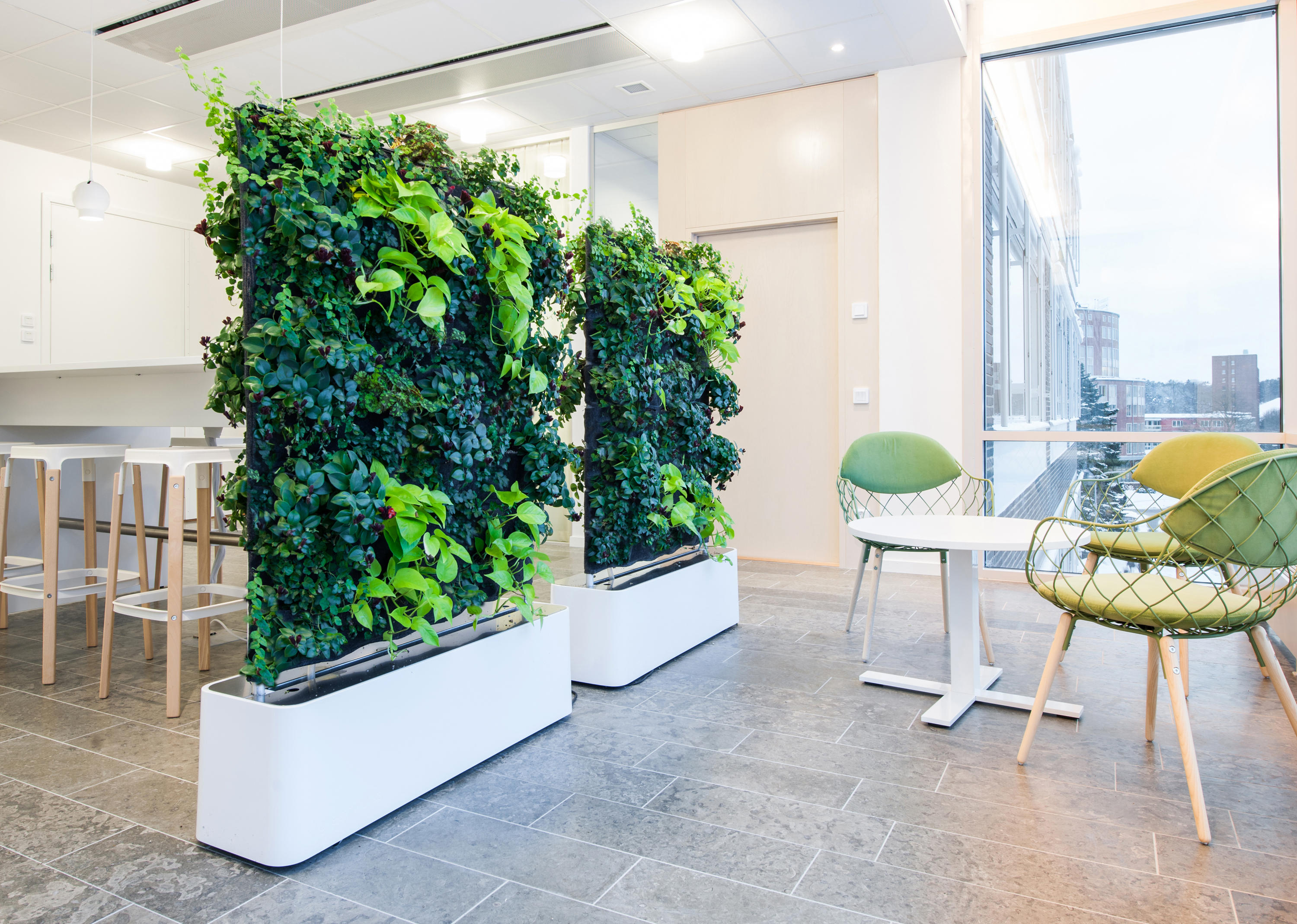
You can section off a room with plants if you’d want to bring some vegetation into your abode at the same time. Creating a natural barrier between two locations can be accomplished by positioning a large planter or a collection of smaller plants in the space that exists between the two areas.
- Enhanced aesthetics: Plant wall dividers can add natural beauty to a space, creating a serene and relaxing environment.
- Improved air quality: Plants can help to improve air quality by removing pollutants and releasing oxygen into the air.
- Increased privacy: Tall plants or planters can be used to create a natural barrier, providing some level of privacy while still allowing natural light to pass through.
- Reduced stress: Being around plants has been shown to reduce stress and improve moods, adding plants to a space can help to create a more positive and inviting environment.
- Increased biodiversity: Plant wall dividers can help to support the growth of local wildlife and increase biodiversity in the area.
- Cost-effective: A plant wall can be an affordable way to divide a room, especially when compared to building permanent walls or other dividers, and it adds living elements to the space.
- Maintenance: Plant wall dividers will require regular care, such as watering and fertilizing, to maintain their health and appearance.
- Limited privacy: Depending on the size and type of plants used, a plant wall may not provide complete privacy and could be see-through.
- Light requirements: Some plants require specific light levels to thrive, so it’s important to choose plants that are suitable for the location and amount of natural light available.
- Allergies: For some people with allergies, plants can be a trigger, and they should avoid or limit exposure to them.
- Pests & Diseases: Plants can be susceptible to pests and diseases which can lead to damage or death of the plants.
- Space-consuming: Plant walls take up space, not only for the plants themselves but also the planters and equipment needed to maintain them.
- Climate: depending on the location, some plants may not be suitable for the climate and could die, it’s important to research the plants that suit the area best.
- Water Usage: Plant walls can be quite demanding when it comes to water usage, in some areas with water restrictions, it may not be possible to have a plant wall.
6. Glass Room Divider

These room dividers are composed of glass and can be utilised to give a space an air of sophistication and contemporary style. They can be arranged in such a way as to produce an impression of separation while still preserving the room’s open and breezy atmosphere.
- Increased natural light: Glass walls allow natural light to pass through, creating a bright and airy space.
- Enhanced aesthetics: Glass walls can add a modern and sleek look to a space and can complement any decor.
- Increased functionality: Glass walls can be used as room dividers, partition walls, or as a way to create a separate workspace or display area.
- Increased flexibility: Glass walls can be used to create a temporary or permanent separation of space, and it can be easily dismantled or moved around as needed.
- Improved privacy: Glass walls can be designed to provide privacy while still allowing natural light to enter the space, and it can be frosted or etched to provide more privacy if needed.
- Cost-effective: Glass walls can be less expensive than traditional walls, especially when it comes to labor and materials costs.
- Limited soundproofing: Glass walls may not provide as much sound insulation as solid walls, and it may require additional soundproofing to reduce noise between spaces.
- Fragility: Glass walls can be fragile and can be easily damaged if not handled properly, it may require more maintenance and repairs than other types of walls.
- Privacy: Clear glass walls can lack privacy, and it’s necessary to use frosted or etched glass, or use curtains or shades to add privacy if needed.
- Safety concerns: Glass walls are not fire-proof, which can be a concern in case of emergencies.
- Cost: While glass walls can be less expensive than traditional walls, custom-made or high-quality glass walls can be quite costly.
- Cleaning: Glass walls are more prone to get smudged and require frequent cleaning.
- Climate: In some areas with extreme weather, tempered or laminated glass may be required for safety and durability, adding to the cost.
- Installation: Glass walls require professional installation, and it should be handled by experienced technicians to ensure proper installation and safety.
7. Bamboo Room Dividers
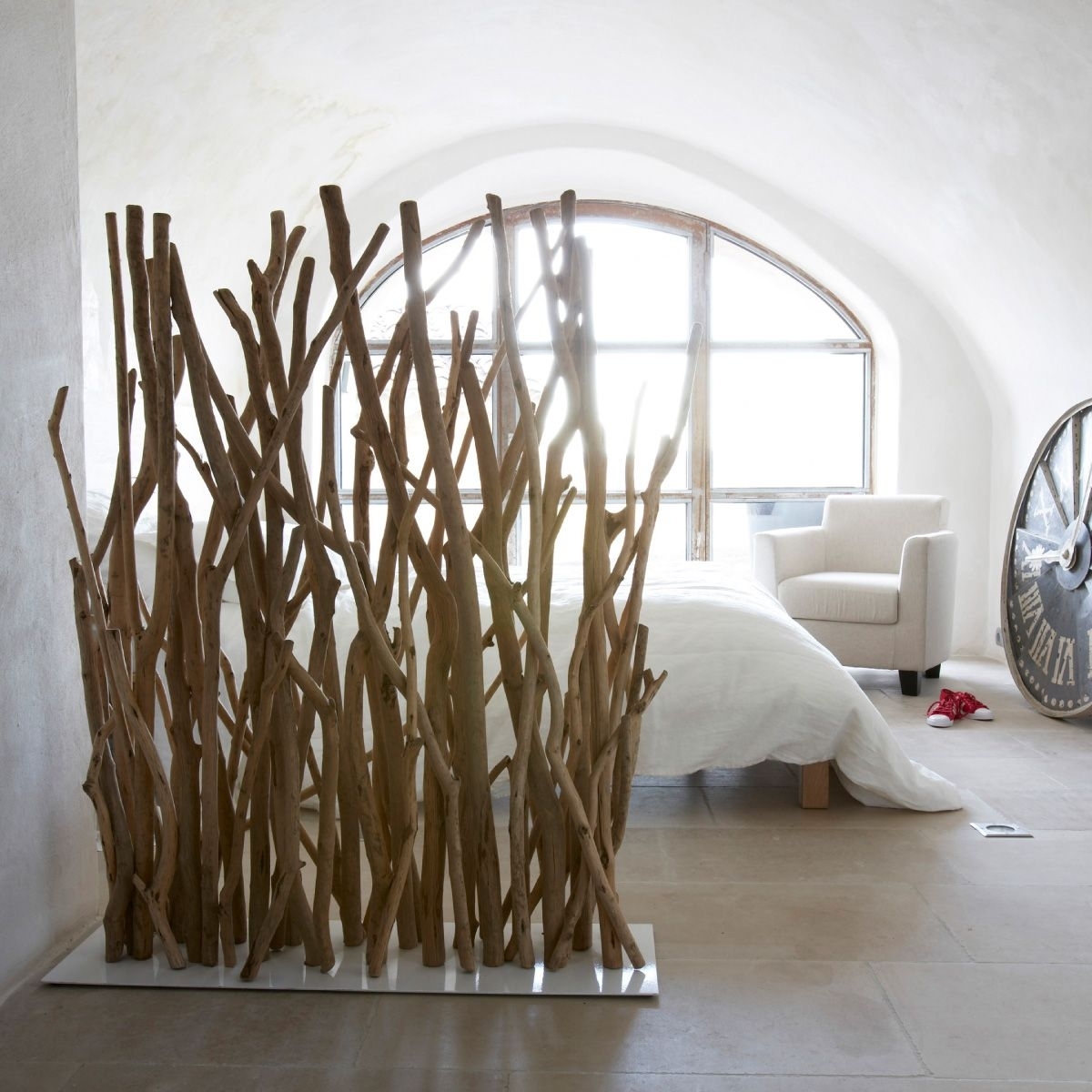
Bamboo is a material that can be harvested for a long time and has a low impact on the environment. They are easy to transport because to their portability and lightweight design, and they may lend a room an air that is either rustic or tropical.
- Sustainable: Bamboo is a highly renewable resource, making bamboo wall dividers an environmentally friendly choice.
- Lightweight: Compared to other materials, bamboo is relatively lightweight, making it easy to move and reposition.
- Affordable: Bamboo wall dividers are often less expensive than other types of room dividers.
- Versatile: Bamboo wall dividers come in a variety of styles and designs, making it easy to find one that fits your aesthetic.
- Natural look: The natural aesthetic of bamboo can add warmth and texture to a room.
- Durability: Bamboo is a relatively soft wood, and may not be as durable as other materials like hardwood.
- Potential for warping: Bamboo is a natural material and can be affected by changes in humidity and temperature, which can cause it to warp or crack over time.
- Maintenance: Bamboo can be prone to staining and discoloration if it’s not properly sealed or maintained.
- May not be suitable for some environments: Bamboo may not hold up as well in humid climates or in rooms with high foot traffic.
8. Loft-Style Room Divider

A room can be given a contemporary and industrial feel by utilising a room divider designed in the shape of a loft, which can also be utilised to divide a huge open space. This category of room divider is typically constructed out of metal or wood, and its surface can be painted or left untreated.
- Aesthetically pleasing: Loft-style room dividers can add a modern, industrial aesthetic to a space.
- Space-saving: Loft-style room dividers can create a separate living area without taking up valuable floor space.
- Versatile: Loft-style room dividers can be used in a variety of settings, including homes, offices, and commercial spaces.
- Creative use of space: Loft-style room dividers can be used in a variety of ways to divide and define spaces.
- Provide privacy: These dividers can be useful to create secluded areas to separate living and working space.
- Expensive: Loft-style room dividers can be quite expensive to install, especially if they need to be custom-made.
- Not suitable for everyone: Loft-style room dividers may not be suitable for people with mobility issues, as they typically require climbing up and down a ladder or stairs to access the upper level.
- May not meet Building codes: This type of room divider may not comply with certain building codes, as they may require fire safety features such as sprinklers, fire-rated walls, and emergency escape routes.
- Safety hazards: If not properly secured, these dividers can pose safety hazards, such as falls from heights
- Noise: They may not effectively reduce noise between the different levels, so it may not be suitable for bedrooms or noise-sensitive areas.
9. Barn-Door Style Divider

A room can be given a country or farmhouse feel by utilizing a partition in the form of barn doors to get the desired effect. The use of reclaimed wood or barnwood in the construction of this sort of room divider can lend an atmosphere of cosiness and character to the area.
- Aesthetically pleasing: Barn-door style dividers can add a rustic, industrial, or farmhouse aesthetic to a space.
- Space-saving: Sliding barn doors do not require any floor space to open and close, allowing you to maximize the floor space of your room.
- Versatile: Barn-door style dividers can be used to divide any room, such as bedrooms, bathrooms, closets, and kitchens, etc.
- Durable: Many barn door hardware systems are built to last and can handle the weight of solid wood and heavy doors.
- Customizable: Can be customized to match with the decor and style of any room, also available in different colors and materials.
- Installation may be difficult: Installing barn-door style dividers can be challenging, especially if you need to make modifications to the door frame or install new tracks and hardware.
- May not be suitable for all spaces: Barn-door style dividers may not be suitable for small spaces, as they require a certain amount of clearance for the door to slide open and closed.
- Noise: The barn doors can make noise when opened or closed, which may not be ideal for quiet spaces such as bedrooms or home offices.
- Limited privacy: Barn-door style dividers may not provide complete privacy and might not be suitable for spaces that require more privacy.
- May not be suitable for all climates: Humidity and temperature change may cause wooden barn door to warp or expand making it difficult to slide, also heavy exposure to sun may cause fading.
10. Pipe and Drape Room Divider
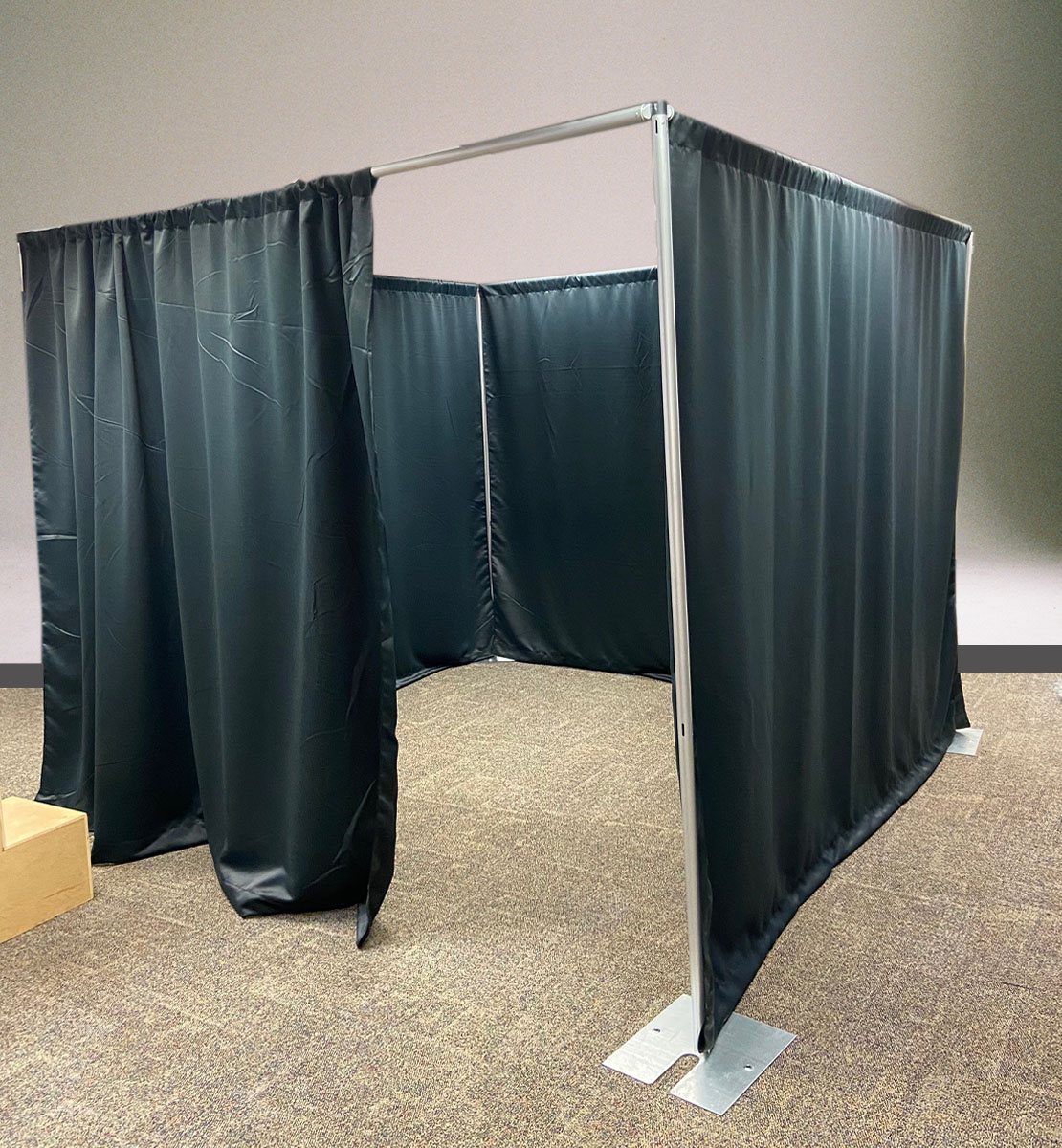
Creating temporary barriers or dividers with pipe and drape is a regular task at events such as weddings, trade fairs, and conventions, where the use of pipe and drape is widespread. They are simple to set up, adjust, and take down because they are constructed out of pipes and hefty materials.
- Flexibility: Pipe and drape wall dividers are highly versatile and can be configured in a variety of ways to divide a space. They can also be easily reconfigured or removed as needed.
- Cost-effective: Pipe and drape wall dividers are relatively inexpensive compared to other types of room dividers and are often available for rental.
- Easy to set up and take down: The design and materials make it easy to set up and take down, making it a great option for events, temporary spaces, and on-the-go setups.
- Variety of colors and fabrics: Available in a variety of colors, textures and fabrics, so you can choose the one that best suits your needs and preferences.
- Conceals uneven or unsightly walls: It can be used to cover up uneven or unsightly walls, making it a great solution for temporary spaces or events.
- Not permanent: Pipe and drape wall dividers are not meant to be permanent partitions, and are typically only used for temporary events or situations.
- May not provide complete privacy: Pipe and drape wall dividers may not provide complete privacy, and may not be suitable for spaces that require more privacy.
- Noise: The drapes may not effectively block sound, so they may not be suitable for spaces that require more sound insulation.
- May not be suitable for all spaces: Pipe and drape wall dividers may not be suitable for all spaces, and may not be an ideal solution for rooms that require more permanent dividers.
- May not stand well without proper weight: It’s not a stable solution and needs to be weighted down properly, otherwise it may fall or create hazards.
11. Shoji-style Room Divider
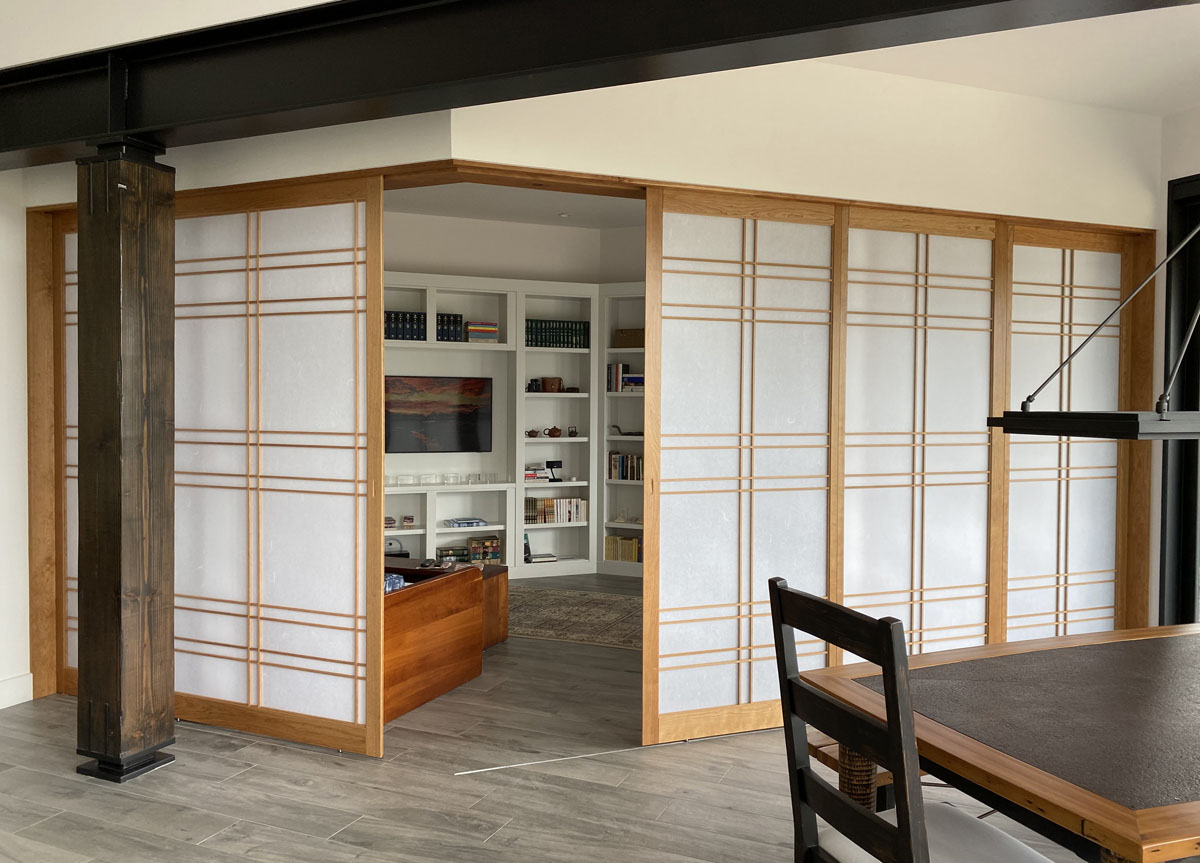
Traditional Japanese room separators are known as shoji, and they consist of a wooden frame with rice paper panels installed within it. They are ideal for imparting a sense of Zen to any environment while enabling natural light to diffuse across the area of the room they are in.
- Aesthetically pleasing: Shoji-style wall dividers can add a Zen, Asian, or minimalist aesthetic to a space.
- Lightweight: Shoji-style wall dividers are relatively lightweight, making them easy to move and reposition.
- Provides soft light: Rice paper or other translucent materials used in shoji-style wall dividers allow soft light to filter through, creating a warm and inviting atmosphere.
- Versatile: Shoji-style wall dividers can be used to divide any room, and are suitable for both residential and commercial settings.
- Customizable: Can be customized to match the decor and style of any room, also available in different colors and materials.
- Fragility: Rice paper or other translucent materials used in shoji-style wall dividers are fragile and can tear or become discolored over time.
- Not suitable for humid environments: Rice paper or other translucent materials used in shoji-style wall dividers can become wrinkled or warped if exposed to high humidity.
- Need maintenance: Shoji-style wall dividers may require regular maintenance to ensure they remain in good condition.
- Not providing full privacy: Translucent materials used in shoji-style wall dividers will not provide full privacy, and may not be suitable for spaces that require more privacy.
- Not suitable for all climates: Humidity and temperature change may cause wooden frames to warp or expand, making it difficult to open or close.
12. Wicker or rattan dividers

These room dividers made from natural fibres can provide a feeling of cosiness and warmth to the space they’re in. They are available in a wide range of designs and dimensions, and one can employ them to produce an impression of seclusion or to section off an area of a room.
- Aesthetically pleasing: Wicker or rattan dividers can add a natural, earthy, or rustic aesthetic to a space.
- Lightweight: Wicker or rattan dividers are lightweight, making them easy to move and reposition.
- Durable: Wicker or rattan dividers made from quality materials and with proper care, can last for many years.
- Affordable: Wicker or rattan dividers are often less expensive than other types of room dividers.
- Sustainable: Wicker or rattan is a highly renewable resource and considered a sustainable material, making them an environmentally friendly choice.
- Not suitable for all climates: Wicker or rattan dividers may not hold up as well in humid climates, as the moisture can cause the material to warp or rot over time.
- Not suitable for high traffic areas: Wicker or rattan dividers may not be suitable for rooms with high foot traffic, as the constant movement can cause wear and tear over time.
- Potentially allergenic: Wicker or rattan dividers may cause allergic reactions to some people.
- Need maintenance: Wicker or rattan dividers may require regular maintenance to ensure they remain in good condition, such as dusting, or oiling them to prevent cracking.
- May not provide complete privacy: Wicker or rattan dividers are often woven with gaps in between the fibers that can let light through and can’t provide complete privacy.
13. Metal Wall Dividers
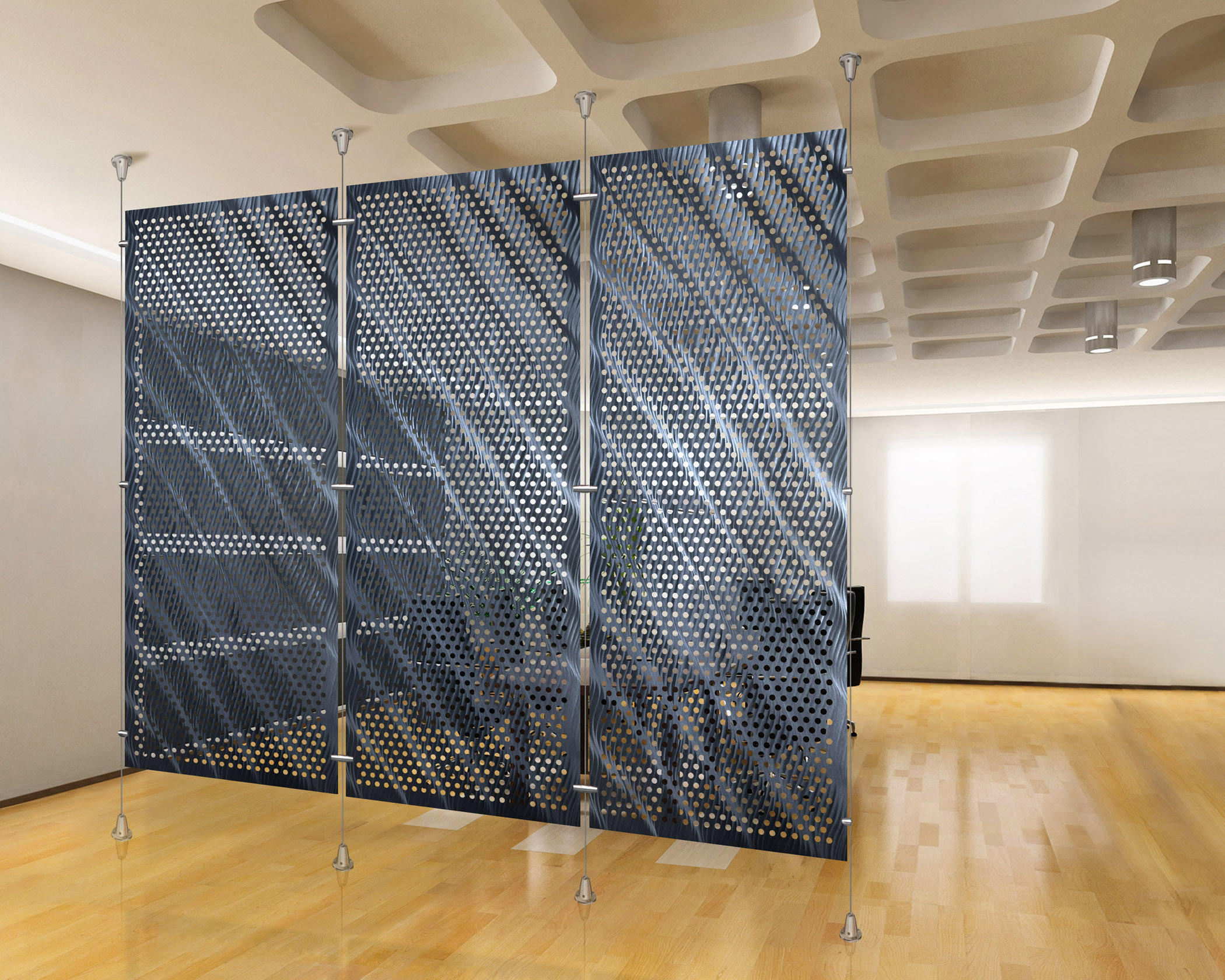
These can give a room an air of industrial or minimalist aesthetic, depending on your preference. Screens, room dividers, and partitions are all examples of the several types of metal dividers that are available. These dividers can be fabricated from a wide number of materials such as steel, aluminium, or brass.
- Durable: Metal wall dividers are sturdy and durable, able to withstand heavy use and wear and tear over time.
- Versatile: Metal wall dividers come in a variety of styles and designs, making it easy to find one that fits your aesthetic.
- Low maintenance: Metal wall dividers are easy to clean and require minimal maintenance, making them a good option for high-traffic areas.
- Fire-resistant: Metal wall dividers are non-combustible and can resist fire, which makes them suitable for use in public spaces or commercial buildings.
- Customizable: Many metal wall dividers can be customized to fit specific sizes or design needs.
- Expensive: Metal wall dividers can be expensive, especially if they are custom-made or made from high-end materials.
- Cold to the touch: Metal wall dividers can be cold to the touch, which may not be suitable for certain spaces or climates.
- Heavy: Metal wall dividers can be quite heavy, making them difficult to move or reposition.
- May not provide complete privacy: Metal wall dividers may not provide complete privacy, and may not be suitable for spaces that require more privacy.
- Rust prone: Metal wall dividers may be prone to rusting if they are not made of rust-resistant materials and if they are not properly sealed or maintained.
14. String lights or lanterns Room divider

You can generate an atmosphere of cosiness and ambience by dividing the space with the help of string lights or lanterns. They can be affixed to the ceiling, a wall, or even a divider screen by being hanged in one of those three locations.
- Aesthetically pleasing: String lights or lanterns can add a warm, cozy, and romantic atmosphere to a space.
- Customizable: String lights or lanterns come in a variety of styles, colors, and sizes, making it easy to create a personalized look.
- Low-cost: String lights or lanterns are relatively inexpensive, and can be found at most home goods or hardware stores.
- Easy to install: String lights or lanterns can be easy to install and can be used in a variety of settings, both indoors and outdoors.
- Lightweight: String lights or lanterns are lightweight, making them easy to move and reposition.
- Not suitable for all climates: String lights or lanterns may not be suitable for all climates, as the heat generated by the lights can cause damage over time, or in case of rain, wind, or extreme temperatures.
- Not suitable for all spaces: String lights or lanterns may not be suitable for spaces that require more privacy, as they do not block light completely.
- Safety hazard: String lights or lanterns can pose a fire hazard if they are not properly installed, or if they are damaged.
- Limited Privacy: String lights or lanterns will not provide complete privacy, they are often used more as a decorative feature rather than a functional wall divider.
- Maintenance: String lights or lanterns may require regular maintenance such as cleaning, and changing of light bulbs.
15. Wooden pallet dividers

Because they are so versatile, you may easily repurpose or recycle them after you’ve used them to create a rustic or industrial look. It is possible to construct a wall out of wooden pallets by stacking them one on top of the other, or you can construct a rustic screen using the pallets by disassembling them and arranging them in a grid pattern.
- Wooden pallet dividers are a cost-effective option for many businesses.
- They are a sustainable and environmentally-friendly choice, as they can be made from reclaimed or recycled wood.
- Wood is a durable material that can withstand rough handling during storage and transportation.
- Wooden pallet dividers can be easily customized to fit specific products or pallet sizes.
- Wooden pallet dividers can be heavy and bulky, which can make them difficult to handle and store when not in use.
- They may absorb moisture or warp over time if they are not treated with a protective coating.
- They are not fire resistance, making them less safe to use in industries that has fire risk.
- If they’re not treated with the right chemical, they may attract pests or termites.
16. Recycled materials dividers

By decorating your room with recycled materials like old shutters, window frames, or metal grates, you can give it a more industrial, vintage, or rustic appearance while also doing your part to protect the environment.
- Recycled materials dividers are a sustainable and environmentally-friendly option, as they reduce the need for new materials and decrease waste.
- They are often made from durable and long-lasting materials, such as plastic or metal, which can withstand rough handling during storage and transportation.
- Recycled materials dividers can be easy to clean and maintain, making them suitable for use in food and beverage industries.
- They are often made from materials that can be recycled or repurposed again at the end of their useful life.
- Recycled materials dividers may be less customizable than other options, as the materials used may be limited to what is available at the time of production.
- They may be costlier than new materials, as they can be more expensive to acquire, sort and process.
- These dividers are not biodegradable, so they will last longer in landfills and can be detrimental to the environment if not properly disposed.
- They may not be fire resistant which can cause safety hazards.
17. Soundproofing Room Divider
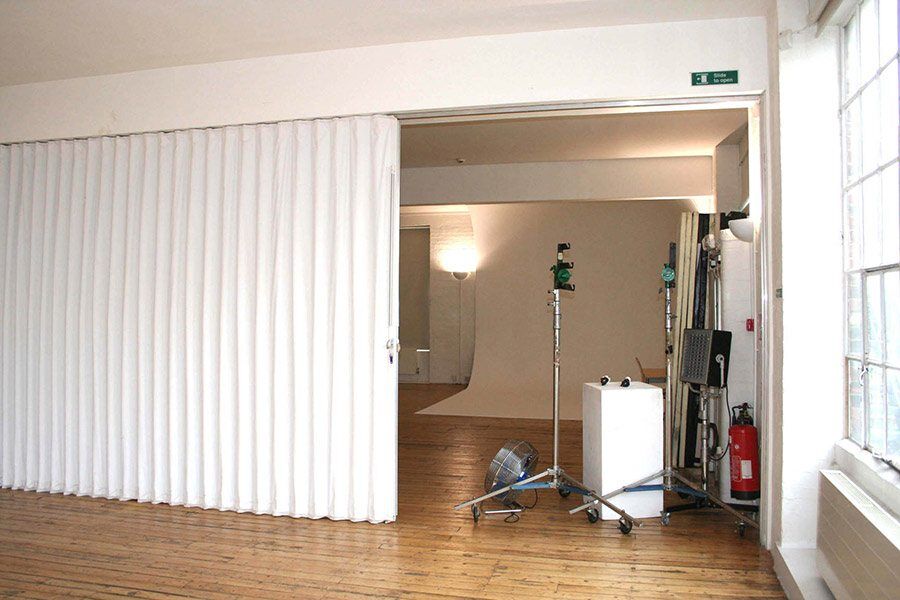
You can lessen the amount of noise and nonetheless keep your privacy by utilising soundproofing dividers such as acoustic panels or soundproof drapes in open areas or in areas where there is the potential for sound to be an issue.
- Soundproofing wall dividers can significantly reduce the amount of noise that passes through walls, ceilings, and floors, which can improve the overall acoustics of a space and make it more comfortable to use.
- They can also help to block out exterior noise, such as traffic, construction, and neighborhood sounds, which can improve the quality of life for residents.
- They can also increase privacy and reduce distractions in spaces such as offices, schools, and call centers.
- Soundproofing wall dividers can be costly to install, as they often require specialized materials and expertise.
- They can also be heavy and bulky which can be difficult to install, in some cases it may require structural modification.
- They may also reduce natural light transmission, making a space less bright.
- They may change the aesthetics of the room or space, depending on the design and materials used.



